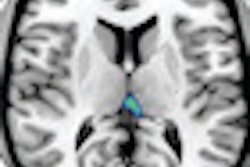That conclusion comes from Korean researchers, whose study enrolled 80 patients who had undergone indirect MR arthrography. Indirect MR arthrograms of 35 patients clinically diagnosed with adhesive capsulitis were compared with arthrograms of 45 patients with no signs of the condition.
The thickness of the joint capsule in the axillary recess was measured on T2-weighted coronal images, while the thickness of the enhancing portion of axillary recess and rotator cuff interval were evaluated on fat-saturated enhanced T1-weighted coronal and sagittal images.
The researchers found that patients with adhesive capsulitis had a significantly thickened joint capsule in the axillary recess and a significantly thickened enhancing portion of joint capsule in the axillary recess and rotator cuff interval. Enhancement of the subscapularis muscle also was observed more frequently in patients with adhesive capsulitis than in patients without adhesive capsulitis.
"Indirect MR arthrography has several advantages compared to other modalities," said study co-author Kyoung Doo Song, MD, from Samsung Medical Center and Sungkyunkwan University School of Medicine in Seoul. "It is noninvasive and does not need exact scan timing. It can show enhancement more clearly. Finally, it can evaluate pathology in both intra-articular space and surrounding tissues."
With these advantages, Song added that indirect MR arthrography also may be used to exclude other diseases mimicking adhesive capsulitis.



















